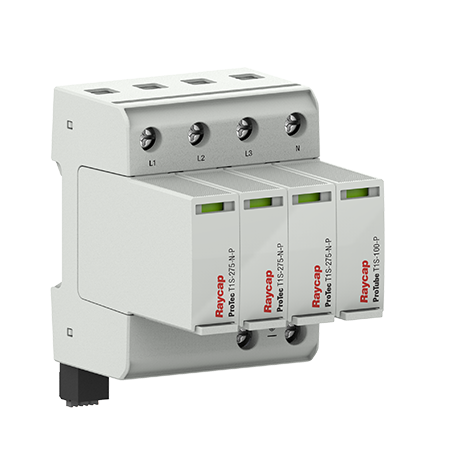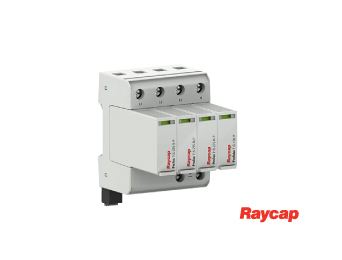Garching, April 21, 2020 – Raycap, an international manufacturer of electronic components for surge protection, connectivity, and monitoring, is expanding its portfolio. ProTec T1S is currently the most compact pluggable surge protection device on the market that meets the requirements of test class I according to IEC 61643-11. The company uses a new multi-cell Phase GDT technology.
 Small, smaller, smallest – For many years, manufacturers of surge protection devices have been working on developing a Surge Protective Device (SPD) with 25 kA 10/350 μs Test Class I in a DIN housing smaller than 2TE. The challenge has now been successfully met by Raycap. With the ProTec T1S, the company offers the first pluggable device on the market that meets these requirements at 25 kA 10/350 μs in a 1HP (17.5 mm) DIN package. In addition, the new SPD provides the necessary voltage switching technology without the disadvantages of a high residual voltage or follow current.
Small, smaller, smallest – For many years, manufacturers of surge protection devices have been working on developing a Surge Protective Device (SPD) with 25 kA 10/350 μs Test Class I in a DIN housing smaller than 2TE. The challenge has now been successfully met by Raycap. With the ProTec T1S, the company offers the first pluggable device on the market that meets these requirements at 25 kA 10/350 μs in a 1HP (17.5 mm) DIN package. In addition, the new SPD provides the necessary voltage switching technology without the disadvantages of a high residual voltage or follow current.
Due to its compact design of only 4HP with the highest discharge capacity of 100 kA 10/350 µs, the ProTec T1S reduces the required installation space by half. At the same time, the SPD protects the downstream built-in devices with one of the fastest tripping characteristics for type 1 surge arresters. This makes it suitable for use wherever maximum safety is required, but space is limited.
Follow Current Control and Package Size as a Challenge
The difficulties in developing a compact pluggable SPD with the above-mentioned requirements using classic surge protection technologies had until now stopped manufacturers from doing so.
For example, voltage-switching SPDs are designed to trigger a conductive state as soon as an overvoltage exceeds a defined threshold. At the same time, they are comparatively simple in design and can provide high surge protection in a compact housing. The problem is, however, that they offer a comparatively poor – i.e. high – protection level and often have problems switching off the follow-on current.
So-called follow current control refers to the ability of an SPD to switch itself out of the circuit as soon as the overvoltage is removed. An SPD with a low follow current control is therefore only suitable for networks where the expected short-circuit current of the mains supply is lower than the follow current rating of the device. If the short-circuit current is higher, there is a risk that the SPD will fail. Voltage-switching SPDs can therefore be implemented compactly and with high overvoltage protection, but have poor follow current control. A circumstance that limits the maximum power for which they can be installed.
Voltage-limiting SPDs such as metal oxide varistors (MOV), on the other hand, are designed to protect a device by limiting overvoltages by switching to a low impedance state. Unlike voltage-switching SPDs, the problem of switching off the follow-on current is not important for them, as they return to their high-impedance state after the overvoltage. Voltage-limiting SPDs can therefore be installed in any power supply system – regardless of the expected residual current. They also offer a good level of protection. Although they compensate for the disadvantages of voltage switching SPDs, they require a larger design if the required overvoltage value of a Class I SPD is to be achieved.
The Best of Two Worlds
In order to develop an ideal class I SPD, Raycap therefore relies on a new technology called Phase Gas Discharge Tube (PGDT) for the ProTec T1S. The multi-cell, encapsulated GDT technology combines the features of voltage limiting and voltage switching SPDs. Voltage switching technology allows a small installation space without the disadvantages of a high residual voltage or a poor follow current rating. A novel multi-cell design reduces the follow-on current to such an extent that ProTec T1S behaves similarly to MOV-based technologies and can therefore also be installed in networks with high prospective short-circuit residual currents (SCCR). And this with half the footprint of products from other suppliers, which optimizes space utilization in the control cabinet.
Raycap has many years of experience in the development and production of reliable and durable products. The combination of this know-how with the new PGDT technology offers users a solution for demanding environments where repetitive surge events occur. At the same time, the ProTec T1S protects systems against lightning events under demanding grid conditions such as grid faults or very high prospective currents without affecting the grid.
Further Features and Advantages of PGDT Technology
Due to the PGDT technology used, the SPDs of the ProTec T1S series comply with IEC Class I according to IEC 61643-11, which means they are suitable for locations where direct or indirect lightning currents according to IEC 62305-4 can be expected. They are also VDE-certified according to the applicable IEC and European standards. Furthermore, the devices have been tested – and are therefore suitable – for repeated operations in networks with an Ip of up to 50 kA 50/60 Hz.
Thanks to a low residual voltage of Up = 1.5 kV, the devices of the ProTec T1S series can be easily coordinated with Class III SPDs in the network. The same applies to properly installed Class II SPDs. The cable length between the products does not have to be considered. In addition, the SPDs have voltage-free communication contacts for remote maintenance and a visual red/green status display. To prevent hot, conductive, ionized gases from escaping, Raycap also uses an encapsulated design. All important parts are housed in a hermetically sealed cell.
Raycap has also thought about the end of the product life cycle during development. The design of the devices allows efficient mechanical and thermal separation. This allows the device to be safely disconnected from the mains and – if necessary – a defect can be reported.
More information about the ProTec T1S as well as other components from the field of surge protection and the other Raycap product series can be found at www.raycap.de



